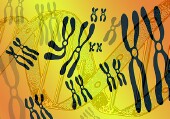
FRIDAY, May 21 (HealthDay News) — Scientists report that they’ve successfully used gene therapy to treat a small number of patients with the condition known as “bubble boy” disease, which robs children of the ability to fight off germs.
The research is preliminary, and another phase of testing is needed before the therapy can get federal approval. Also, the treatment only appears to work in patients with a particular strain of the disease.
Even so, the findings highlight the fact that the disease is becoming easier to treat and the prognosis is improving for these children, said lead investigator Dr. Donald B. Kohn.
“We’re talking about 70 to 90 percent surviving and doing well, and we’re hoping to get that even higher as gene therapy gets more effective,” said Kohn, a pediatric bone-marrow transplant doctor at the University of California at Los Angeles David Geffen School of Medicine.
When they’re born, babies have natural resistance to disease, thanks to immunity that they inherit from their mothers. Over time, if things go well, they develop immune systems of their own. But in some cases the immune systems don’t develop properly and the children become especially vulnerable to disease.
The condition is rare, but it became widely known in the 1980s because of the case of the “Bubble Boy,” a child named David Vetter who lived in a plastic bubble to avoid being infected by germs. He died at the age of 12, and his treatment remains controversial to this day.
Currently, children with the different types of the immune deficiency condition are treated with stem-cell transplants and gene therapy.
In the new study, researchers treated 10 children who had a form of the condition called adenosine deaminase severe combined immunodeficiency that affects 20 percent of those with bubble boy disease.
Researchers, who began the study in 2001, assigned four patients to receive regular treatment with enzyme replacement therapy. Another six stopped that therapy and received chemotherapy designed to create room in their bone marrow for transplanted cells.
“It would be like if you’re in a garden with a high density of plants, and you want to put some new plants in. The best chance for them to grow would be to remove some of the old plants,” explained Dr. Mark Kay, head of the gene therapy program at Stanford University School of Medicine.
Researchers hoped the transplanted cells would create a new immune system and, in half of the six patients, they did just that.
The treatment gives the patients a “key missing piece of genetic information” so their bodies can create a normal immune system, Kohn said. And the cells come from the patient’s own body so there should be less risk that the body will reject the cells or vice versa, he explained.
The study results came in a phase 1 trial, the first of three study phases that treatments must undergo to get federal approval. The second phase of research has already begun.
The treatment is costly, Kohn noted, requiring months of hospitalization.
Kay said the gene therapy treatment may become the standard way to treat bubble boy disease. It could, he said, allow children to undergo just one treatment — a “lifelong cure” — instead of repeatedly taking the enzyme treatment.
The study is scheduled to be released Friday at the annual meeting of the American Society of Gene & Cell Therapy, in Washington D.C.
More information
The Nemours Foundation has more about immune deficiency.

